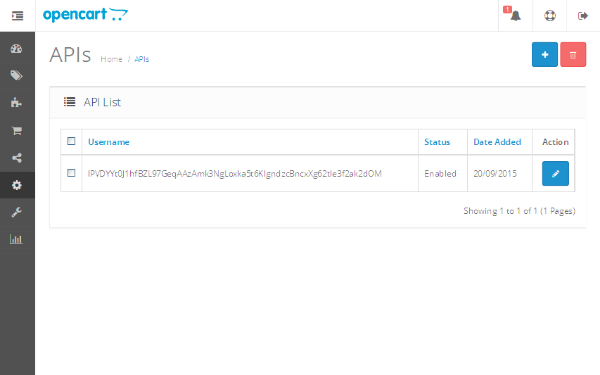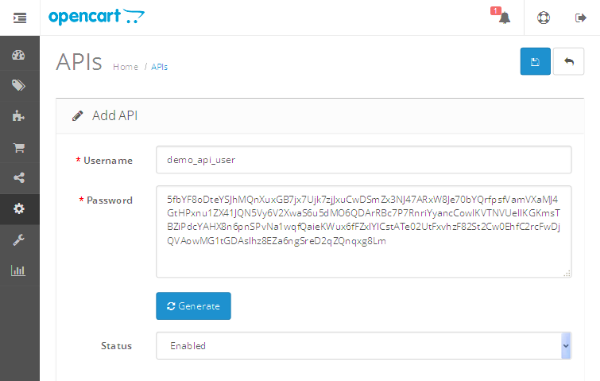You'll see lots of exciting features in the recent major version of OpenCart, ranging from completely responsive design in the front-end and back-end to the event notification system and many more. One of the most powerful among them is the introduction of REST APIs.
In this two-part series, we'll explore most of the APIs available and go through the order creation process using them. In this first part, we'll see how to create an API user credentials and some of the basic API usage.
The REST APIs allow third-party systems to interact with the OpenCart store seamlessly. How about placing orders in your store using the iOS/Android app? In fact, you could think of any system irrespective of the technology it's built upon! The integration is possible now with the set of APIs provided by OpenCart 2.0.
In this part, I'll demonstrate the usage of APIs using the PHP cURL library. So, you'll need the PHP cURL library installed to run the examples. Obviously, you'll need the latest version of OpenCart as well, which is 2.0!
Create API User Credentials
Before we start using APIs, we'll need to set up the "API User" for that. Without that, you can't access it and you'll get a permission denied error. So, let's set that up. Navigate to System > Users > API and it'll list all the API users available.

Click on the + button at the top right to add a new API user.

As you can see, you need to enter Username, Password and Status. You could also use the Generate button to create a complex password string, as I've done! Also, make sure that the Status is set to Enabled. Save the changes and you're good to go!
Now that we've set up the API user, we can start exploring the APIs!
Set Up the Common Files
As we'll see the basic core PHP examples throughout this series, let's make sure that we set up the file which includes the common code to avoid any duplication!
Go ahead and create a common.php file and paste the following contents in that file.
<?php
function do_curl_request($url, $params=array()) {
$ch = curl_init();
curl_setopt($ch,CURLOPT_URL, $url);
curl_setopt($ch, CURLOPT_RETURNTRANSFER, 1);
curl_setopt($ch, CURLOPT_COOKIEJAR, '/tmp/apicookie.txt');
curl_setopt($ch, CURLOPT_COOKIEFILE, '/tmp/apicookie.txt');
$params_string = '';
if (is_array($params) && count($params)) {
foreach($params as $key=>$value) {
$params_string .= $key.'='.$value.'&';
}
rtrim($params_string, '&');
curl_setopt($ch,CURLOPT_POST, count($params));
curl_setopt($ch,CURLOPT_POSTFIELDS, $params_string);
}
//execute post
$result = curl_exec($ch);
//close connection
curl_close($ch);
return $result;
}
As you can see, it contains just one function, do_curl_request, which will make a CURL call to the URL passed by the $url argument. The second argument is an array of parameters in case you need to POST the data.
The other important things to note are the CURLOPT_COOKIEJAR and CURLOPT_COOKIEFILE settings. These set the file in which the cookies will be stored and read from. As we'll need to make authenticated calls, it's a must! Of course, you want to change the path /tmp/apicookie.txt according to your system settings. Make sure that it's writable by the web server too!
Finally, the function returns the response by the CURL request!
How to Log In
Obviously, the first thing to do is to start the session, and you'll need to use the login method. Let's have a look at an example. Go ahead and create a login.php file with the following contents.
<?php require "common.php"; // set up params $url = 'http://your-opencart-store-url/index.php?route=api/login'; $fields = array( 'username' => 'demo_api_user', 'password' => '5fbYF8oDteYSJhMQnXuxGB7jx7Ujk7zjJxuCwDSmZx3NJ47ARxW8Je70bYQrfpsfVamVXaMJ4GtHPxnu1ZX41JQN5Vy6V2XwaS6u5dMO6QDArRBc7P7RnriYyancCowlKVTNVUelIKGKmsTBZiPdcYAHX8n6pnSPvNa1wqfQaieKWux6fFZxIYlCstATe02UtFxvhzF82St2Cw0EhfC2rcFwDjQVAowMG1tGDAsIhz8EZa6ngSreD2qZQnqxg8Lm', ); $json = do_curl_request($url, $fields); $data = json_decode($json); var_dump($data);
First, we've included the common.php file created in the previous section. Next, the $url variable defines the API login url of the OpenCart store. Next, the $fields array holds the API user credentials created earlier. Finally, we call the do_curl_request method to log in.
If everything is set up correctly, you should see a "Success: API session successfully started!" message in the response.
Congratulations! You've just used the login REST API in OpenCart!
How to Add a Product in the Cart
So, now that we've logged in, let's start adding products in our cart! Create a file add_product.php with the following contents.
<?php require "common.php"; // set up params $url = 'http://your-opencart-store-url/index.php?route=api/cart/add'; $fields = array( 'product_id' => '51', 'quantity' => '1' ); $json = do_curl_request($url, $fields); $data = json_decode($json); var_dump($data);
Again, pretty simple stuff here! You need to pass the product_id and quantity parameters to add the product into the cart. You should see the "Success: You have modified your shopping cart!" message in case of success!
How to Edit a Product in the Cart
Before we move ahead, let's try to understand how OpenCart stores the product information in the cart object. Here's how the cart object looks.
stdClass Object
(
...
[products] => Array
(
[0] => stdClass Object
(
[key] => YToxOntzOjEwOiJwcm9kdWN0X2lkIjtpOjUwO30=
[product_id] => 51
[name] => Demo Product
[model] => demoproduct
[option] => Array
(
)
[quantity] => 1
[stock] => 1
[shipping] => 1
[price] => $10.00
[total] => $20.00
[reward] => 0
)
)
...
)
As you can see, it's stored as an array referenced by the products key. The key is also encrypted, so to edit any product entry in the object, you'll need to fetch the associated key using the product_id in the first place!
Now, let's see how to edit the quantity of the product in the cart. Create a file edit_product.php and paste the following contents in that file.
<?php require "common.php"; // get list of products from the "Cart" $url = 'http://your-opencart-store-url/index.php?route=api/cart/products'; $json = do_curl_request($url); $products_data = json_decode($json); // fetch "key" of the product we want to edit $product_key = $products_data->products[0]->key; // edit the product in the "Cart" using "key" $url = 'http://your-opencart-store-url/index.php?route=api/cart/edit'; $fields = array( 'key' => $product_key, 'quantity' => '2' ); $json = do_curl_request($url, $fields); $data = json_decode($json); var_dump($data);
We've made two CURL calls in the above example. The first one is to fetch all the products in the cart, and the second is to update the quantity of the product already in the cart!
To edit any product, you'll need the $key for the product, and you can find it by fetching the complete products array from the cart session.
For the sake of simplicity, I've fetched the key using the 0 index directly. But of course, you'll need to find it using the product_id.
$product_key = $products_data->products[0]->key;
The rest is simple: we're just passing the key and the quantity we would like to update for the product! Again, you should see "Success: You have modified your shopping cart!" in the response to make sure that the quantity is updated properly.
So that's it for today. In the next part of this tutorial, we'll see the rest of the examples to create an order!
Conclusion
Today, we looked at the important "REST APIs" feature in OpenCart. We went through the process of creating an API user, and later on we explored some hands-on examples to understand the usage of the APIs. I would love to hear your thoughts about this exciting feature!


Comments